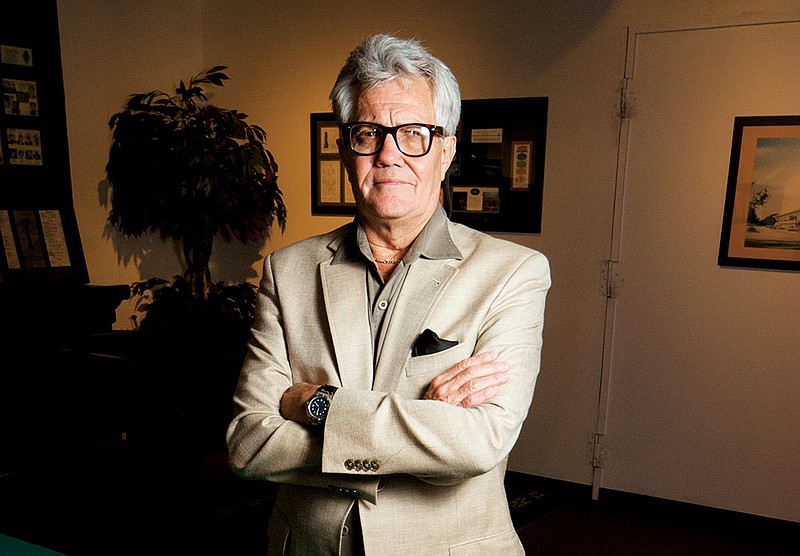HOT SPRINGS — Some people have a collection of stamps or coins, but Robert Raines of Hot Springs has a collection that’s a little bit different. Raines has a collection of gangster memorabilia.
Raines is executive director of the Gangster Museum of America in Hot Springs.
He grew up in Little Rock and Pine Bluff, where he worked in advertising and computers.
Raines is an alumnus of the University of Arkansas at Pine Bluff, where he graduated with a degree in music. He pursued a music career briefly after college, but he came back to Pine Bluff, where he starting working in advertising.
After working in television advertising, Raines said, he started writing copy and producing commercials. While doing this, he started a journey that would soon become his career.
“I came to visit a friend who bought a business on the north end of [Hot Springs] and was helping him move,” Raines said.
Raines said as he sat in the middle of Hot Springs, he realized the beauty the town possessed and how he might want to live there someday.
“My friend said he always had people ask him if Al Capone really came to [Hot Springs],” Raines said.
This statement stuck with Raines, and he went back to Pine Bluff and started researching the gangster scene in Hot Springs.
“I realized that it was a story that really needed to be told about who all visited Hot Springs,” Raines said.
Raines said he thought he needed to tell that story.
“I thought, ‘How can I do this?’” Raines said. “There was no museum in the country devoted to these guys.”
At the time, Raines owned Stryker’s Computers in Pine Bluff and realized it was probably time to get out of the computer business.
“[Then] everyone was starting to sell DSL [Internet], and we didn’t sell it,” Raines said. “There was a lot of
pressure on mom and pop stores then.”
After owning the computer store for 10 years, it was indeed time for Raines to move on to his next project.
The timing proved to be just right, and Raines came back from his journey to Hot Springs to tell his wife, Ann, about his idea.
“I told her, ‘I’m going to build a gangster museum,’” Raines said.
The city of Hot Springs also
proved to be the perfect spot for the museum, Raines said.
“I thought I could talk about the gangsters in the context of the city of Hot Springs,” he said. “At their time, they were rock stars.
“In seven years of [researching gangsters], I haven’t ever found a bad story about these people.”
Raines’ first museum was only 3,500 square feet, but the current museum is 10,000 square feet. It is filled with photos of Al Capone and others, newspaper clippings, statues, and casino memorabilia from various gambling outlets in the city.
“Word gets out pretty quick when you’re researching something,” Raines said.
His museum has allowed Raines to interact with people who had firsthand experiences with gangsters in Hot Springs.
“I learn something new from one citizen of Hot Springs every day,” Raines said.
A lot of the memorabilia in his museum is from family members of Hot Springs gangsters.
Acquiring interviews and memorabilia does, however, have its hiccups at times, Raines said.
“With a lot of these stories, you need two or three unassociated people to tell you the same story,” Raines said.
Aside from running the Gangster Museum of America,
Raines finds time to be a screenwriter for documentaries in Los Angeles.
America’s Best Kept Secret, one documentary Raines worked on, depicts what Hot Springs has to offer.
“It really is America’s best-kept secret,” Raines said. “We have people come here from all over the world.”
Along with doing screenwriting, Raines has collaborated with his wife to write a book about gangsters and the city of Hot Springs that is set for release later this year.
The book, Hot Springs, From Capone to Costello, follows the journey of gangsters in Hot Springs and the adventures on which they embarked.
Raines said he enjoys his job as executive director of the museum.
“It’s like living in the middle of a dream,” Raines said. “This ‘job’ doesn’t seem like a job.”
Because so much of the memorabilia comes from the city’s residents, Raines uses The Gangster Museum to host fundraisers and other events that benefit the community.
“Sometimes we work with the local Civitans and have fundraisers,” Raines said.
The Hot Springs Civitan Club is a group of people who come together to make life better for their neighbors.
Raines said when the Civitans come to the museum, they work the casino equipment as if they were actually working at a casino in Hot Springs.
“They use fake money and everything,” Raines said.
Raines said he doesn’t see himself retiring anytime soon.
“It’s been a ton of fun,” Raines said. “[The museum] keeps growing. The place has a life of its own.”
Staff writer Lisa Burnett can be reached at (501) 244-4307 or lburnett@arkansasonline.com.
